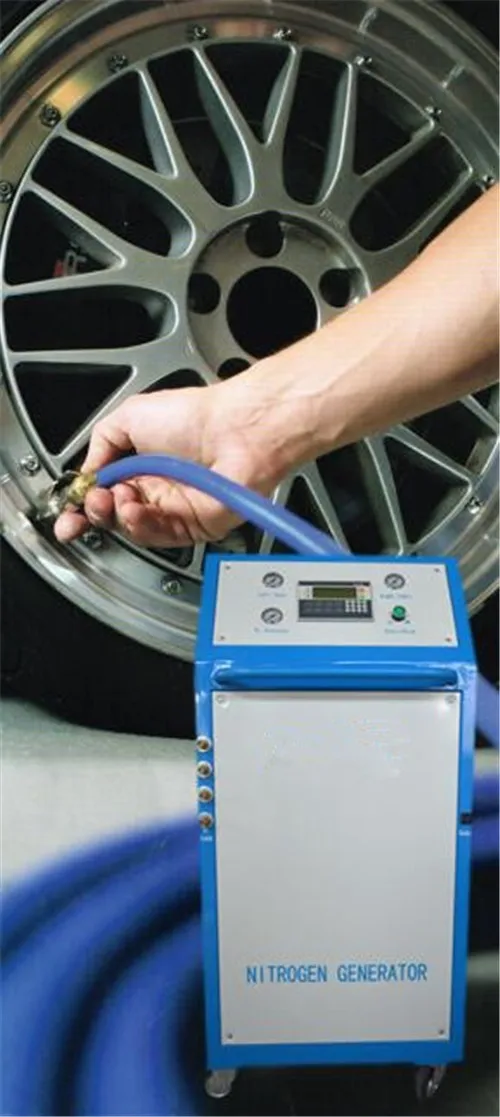Many drivers wonder if they can replace nitrogen with regular air in their tires. While looking for a way to keep tires inflated longer, especially in changing temperatures, some consider inflating them with nitrogen instead of air, or using a combination of the two. This guide can help you decide whether to fill your tires with nitrogen, air, or both.
In general, adding nitrogen to your tires is a typical up-sell tactic at tire shops. There are some benefits in motorsport, and it sounds good in theory, but for the typical car owner, sticking with normal air is perfectly fine. As long as you keep your tire pressures at the correct spec, you're good to go.
Nitrogen tires are filled with nitrogen instead of, or in addition to, regular air. The larger, slower-moving nitrogen molecules seep out of the tire more slowly, and some experts say this can help keep tires inflated longer. Using a combination of nitrogen and air in your tires won't harm them, but it might reduce the effectiveness of the nitrogen fill and cause your tires to deflate more quickly than if you used pure nitrogen. An accurate pressure gauge can help you maintain proper tire pressure, whether using nitrogen or air.
Filling your tires with nitrogen might provide benefits in these areas:
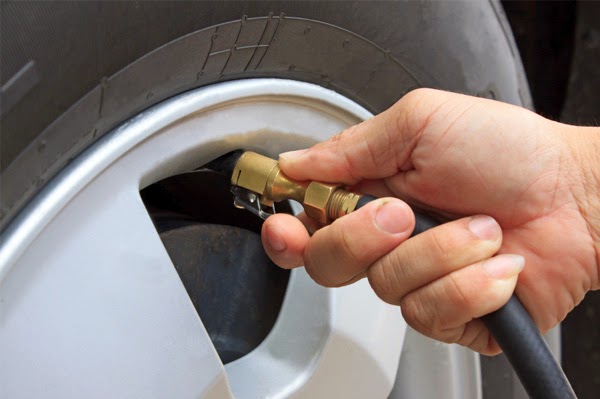
Any tire can be filled with nitrogen instead of air. Here are some considerations when using nitrogen in some common tire types:
Summer TiresStandard summer tires perform well in dry and wet conditions. They often perform best in summer weather or weather that is generally warm and dry. Using nitrogen in your summer tires might help you keep a consistent tire pressure when the temperature changes drastically, such as a cool summer night followed by a very hot day.
Snow TiresSnow tires, or winter tires, use special rubber and tread and sometimes even metal studs to handle wintry conditions such as snow and ice. Nitrogen's extreme weather benefits may be useful in cold conditions, and you might find that you lose less tire pressure during weather fluctuations than if you were to use nitrogen-free air.
All-Season TiresAll-season tires are a safe bet in areas with relatively moderate conditions, including temperate winters. They offer modest traction and don't need to be replaced seasonally. Filling your all-season tires with nitrogen might help you retain tire pressure through seasonal temperature shifts, especially when the seasons change.
They offer modest traction and don't need to be replaced seasonally. Filling your all-season tires with nitrogen might help you retain tire pressure through seasonal temperature shifts, especially when the seasons change.
Performance tires are often used for high-speed or luxury vehicles. They are often a low-profile, wide tire with shallow treads and increased traction in some conditions. Nitrogen offers the same benefits in performance tires as it does in other tire types, including less frequent top-offs.
Off-Road TiresOff-road tires are used for vehicles that can handle rough conditions such as rocks, mud, and deep snow. They are usually durable with deep tread. Using nitrogen in your off-road tires might help you control your tire pressure specifically for the conditions you expect out on the terrain.
Things to Think About when Considering Nitrogen for Your TiresWhen you are deciding whether to use nitrogen in your tires, keep these factors in mind:
 Most locations charge to fill your tires with nitrogen. You might also purchase tires that come pre-filled with nitrogen. Research nitrogen tire fill costs in your area and consider the expense before purchasing your tires. Remember that you might not have to refill your tires as often when you use nitrogen compared to air.
Most locations charge to fill your tires with nitrogen. You might also purchase tires that come pre-filled with nitrogen. Research nitrogen tire fill costs in your area and consider the expense before purchasing your tires. Remember that you might not have to refill your tires as often when you use nitrogen compared to air. Ease of access might impact your decision to fill your tires with nitrogen, especially if you prefer to avoid mixing nitrogen and air to preserve the full benefits of nitrogen tires. If you plan to travel, you might consider researching nitrogen dealers in locations you plan to visit, particularly if you need to fill your tires while you are away.
Ease of access might impact your decision to fill your tires with nitrogen, especially if you prefer to avoid mixing nitrogen and air to preserve the full benefits of nitrogen tires. If you plan to travel, you might consider researching nitrogen dealers in locations you plan to visit, particularly if you need to fill your tires while you are away.Your local tire dealer can help you fill your tires with nitrogen for the first time. They will usually remove the regular air from your tires and then refill them with nitrogen multiple times. This helps eliminate any remaining oxygen and moisture inside.
To top off or refill your tires with nitrogen, visit a dealer or tire shop near you. Some retailers may only fill tires that were purchased from them and others might require a membership.
If you find that you are in a situation that calls for a top-off or reinflation and you are away from a nitrogen dealer, use whichever source of air you can find. Maintaining proper tire pressure is more important than the composition of the air in the tire. Properly inflated tires handle better, may get better gas mileage, wear more evenly, and can help keep you safer on the road. You can always return to a dealer for a full nitrogen fill when you get to another area.
Maintaining proper tire pressure is more important than the composition of the air in the tire. Properly inflated tires handle better, may get better gas mileage, wear more evenly, and can help keep you safer on the road. You can always return to a dealer for a full nitrogen fill when you get to another area.
Make sure to verify the correct tire size for your vehicle.
Hearst Autos Gear Team The Hearst Autos Gear Team is dedicated to bringing you the very best in automotive tools, parts, and accessories, based on the expertise of the editors of Car and Driver, Road & Track, and Autoweek.
Are you considering using nitrogen instead of compressed air in your vehicle's tires? Perhaps you've heard that nitrogen-filled tires stay inflated longer, saving you money by increasing your gas mileage and extending tread life.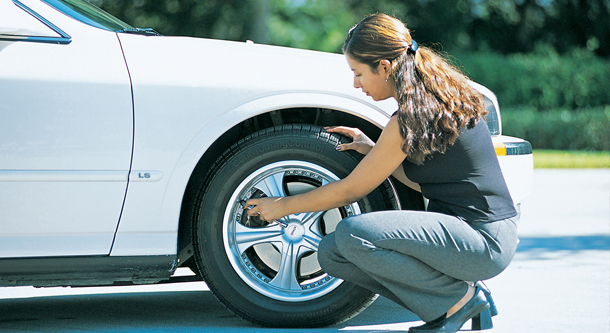 But you're concerned that you may not always be able to find a source of nitrogen when you need to top off your tires. So, in a pinch, can you add air to a nitrogen-filled tire? We've done the research, and we have the answers for you!
But you're concerned that you may not always be able to find a source of nitrogen when you need to top off your tires. So, in a pinch, can you add air to a nitrogen-filled tire? We've done the research, and we have the answers for you!
Yes, you can add air to a tire that has nitrogen in it. In fact, air is comprised of 78% nitrogen, 21% oxygen, and 1% other gases—topping off a nitrogen-filled tire with air will simply dilute the pure nitrogen with a small amount of oxygen.
Nitrogen and oxygen do not react adversely with each other; there is no reason you can't mix them. However, diluting the purity of the nitrogen in your tires will reduce its effectiveness in keeping the tires inflated, so you may lose most of the benefits that the nitrogen fill provides.
Before you continue reading, let us say we hope you find the links here useful. If you purchase something through a link on this page, we may get a commission, so thank you!
In this article, we'll describe why it's okay to mix air and nitrogen in your tires and what the drawbacks are of doing so. We will also discuss whether it's better to fill your tires with nitrogen or with compressed air and whether you can put nitrogen in your tires at home. And we'll let you know how to tell if your tires are filled with nitrogen, how long nitrogen-filled tires remain inflated, and how often you should check the pressure on your nitrogen-filled tires. Without further ado, let's get into it!
We will also discuss whether it's better to fill your tires with nitrogen or with compressed air and whether you can put nitrogen in your tires at home. And we'll let you know how to tell if your tires are filled with nitrogen, how long nitrogen-filled tires remain inflated, and how often you should check the pressure on your nitrogen-filled tires. Without further ado, let's get into it!
The rubber in your vehicle's tires has microscopic gaps that allow molecules of oxygen to escape. Air-filled tires lose about 1.5 psi (pounds per square inch) of pressure every month. This results in lower gas mileage, uneven tread wear, and sluggish handling.
To combat this issue, some drivers use nitrogen in their tires instead of air. Nitrogen molecules are larger than oxygen molecules, so they don't escape as quickly through those tiny gaps in the rubber.
Thus, nitrogen-filled tires deflate more slowly than those filled with air.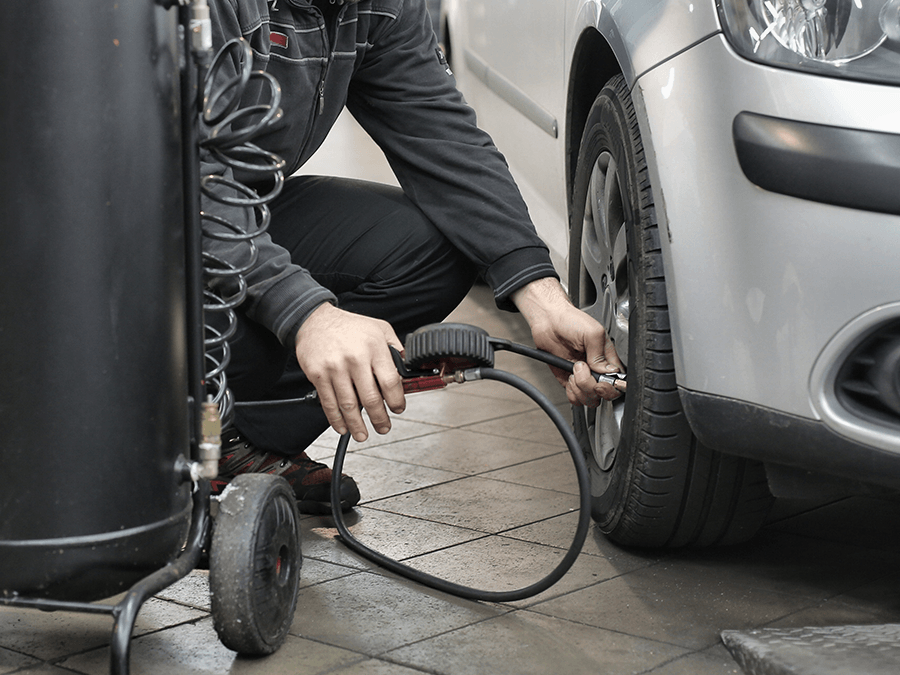 In fact, nitrogen is widely used in racecars and aircraft, for which maintaining tire inflation is critical.
In fact, nitrogen is widely used in racecars and aircraft, for which maintaining tire inflation is critical.
A few drivers currently use nitrogen tires for everyday driving, but nitrogen refills can be hard to find. You may find yourself needing to top off your tires, but with no nitrogen available.
In that case, it is okay to add air to your nitrogen-filled tires. Air consists of 78% nitrogen, plus 21% oxygen and 1% other gases. Adding this mixture to the pure nitrogen in your tires will not cause an adverse chemical reaction.
Remember, though, that oxygen seeps out of your tires more quickly than nitrogen, so adding air will increase the rate of deflation. This may negate all the benefits you got by inflating your tires with nitrogen in the first place.
Still, it is better to use air to fully inflate your tires than to drive on soft tires until you can find nitrogen.
Advocates of nitrogen tires cite two major benefits:
 Properly inflated tires mean better gas mileage, more even treadwear (and thus longer tire life), and easier vehicle handling.
Properly inflated tires mean better gas mileage, more even treadwear (and thus longer tire life), and easier vehicle handling.However, skeptics point to research that shows these benefits to be minimal. They also raise two important disadvantages to using nitrogen in tires:
Ultimately, the decision to use nitrogen or air in your vehicle's tires comes down to your own preference.
If you desire optimal performance, have a nearby source of nitrogen, and are willing to regularly check and maintain your tires' pressure, then using nitrogen may be worth the extra expense and hassle. If not, you will be better off to continue using air in your tires.
If not, you will be better off to continue using air in your tires.
Click here for a full nitrogen cylinder on Amazon.
You can fill your tires with nitrogen at home. Although this requires a substantial up-front investment, it can save you money and hassle in the long run.
You will need to purchase the following items:
Click here for vehicle lift jack on Amazon.
Follow these steps the first time you fill your tires with nitrogen:
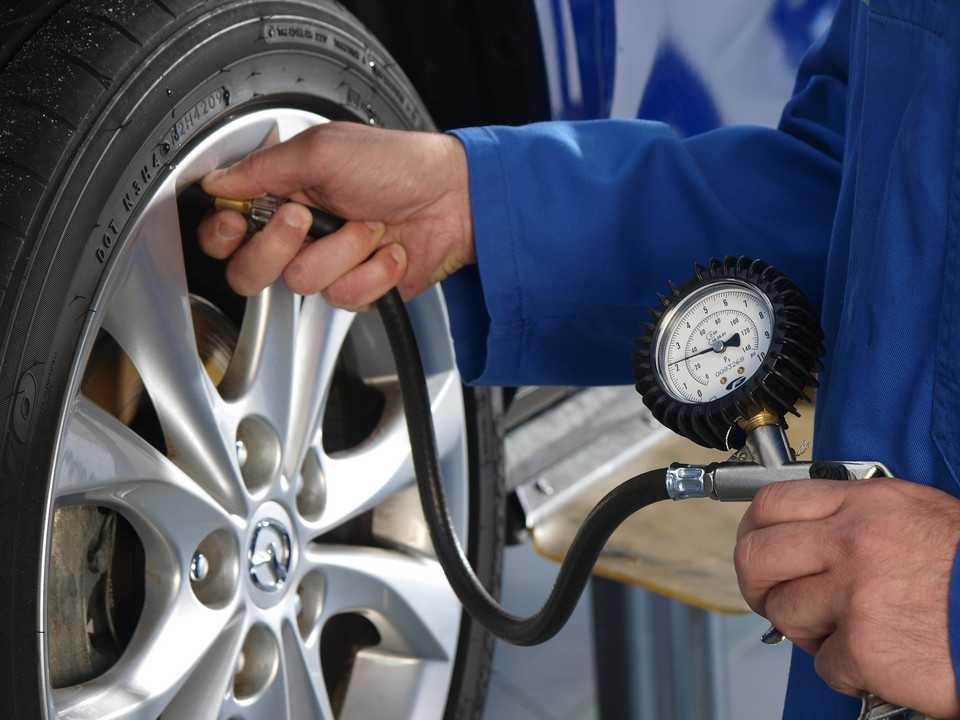
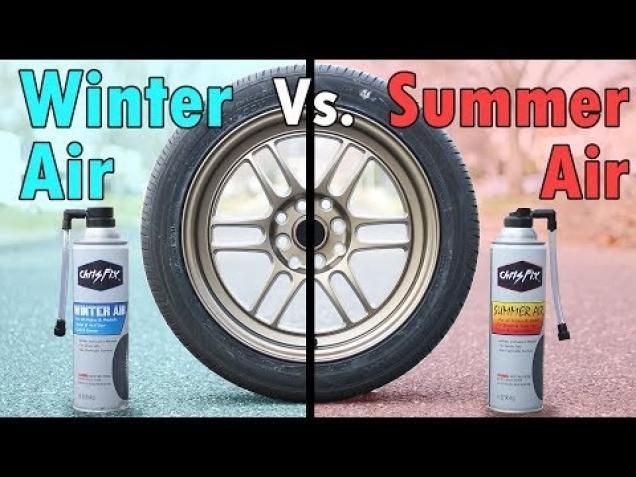
Click here for portable tire inflator on Amazon.
The simplest way to tell if a tire is filled with nitrogen is to look at its valve stem cap. Most dealerships and tire shops put green valve stem caps on nitrogen-filled tires. Many vehicle owners who use nitrogen tires have also adopted this trend.
However, not all nitrogen-filled tires have this easy identifier. If you're not sure whether your tires contain nitrogen or air, there is another way for you to find out. Because air contains only about 78% nitrogen, you can use a nitrogen purity analyzer to determine what's in your tires.
Click here for this nitrogen purity analyzer on Amazon.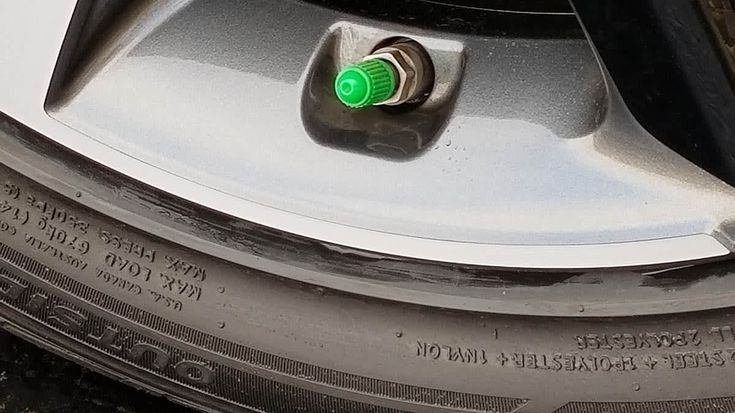
Standard air seeps out of a car tire at a rate of about 1.5 psi per month. Because nitrogen molecules are larger than oxygen molecules, they diffuse more slowly.
Specifically, nitrogen's diffusion rate is estimated to be 1/3 to 2/3 as great as that of normal air. So, nitrogen-filled tires deflate at a rate of about 0.5 to 1.0 psi per month.
When tires deflate 1.5 psi or more below the manufacturer's recommendation, you will begin to see lower gas mileage, uneven tread wear, and, eventually, sluggish handling.
So, as your nitrogen tires deflate, it's important that you continue to monitor the tire pressure and top off the nitrogen regularly.
Many owners don't check their nitrogen tires between oil changes, believing that the tires will remain sufficiently inflated.
However, in the three or four months between oil changes, even nitrogen-filled tires will lose 1.5 to 4.0 psi, which is enough to cause the problems mentioned above.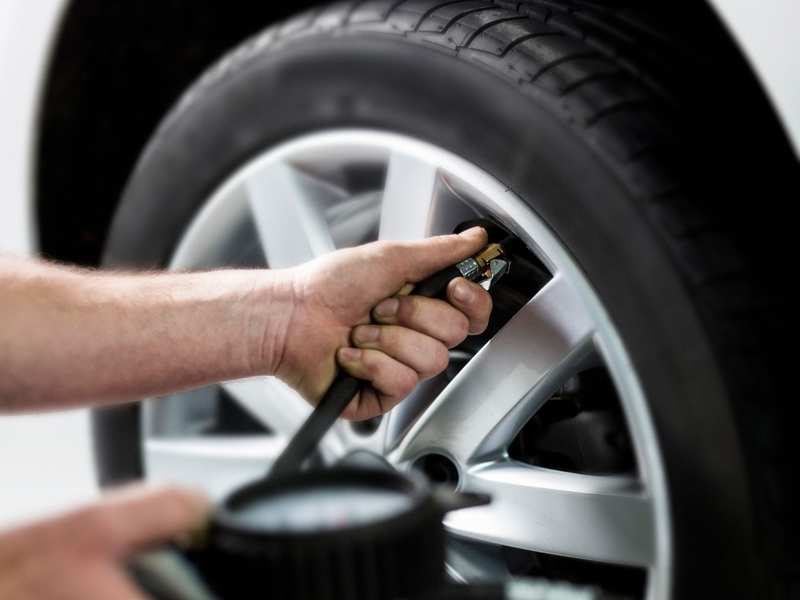
Click here for green valve caps on Amazon.
Even though your nitrogen-filled tires should retain their inflation longer than air-filled tires, it's still important that you check the tire pressure monthly.
If you allow the tire pressure to drop 1.5 psi or more below the manufacturer's recommendation, you will lose all the nitrogen tire benefits that you're paying so much for. A nitrogen fill can never replace vigilance and good tire pressure maintenance!
Click here for this tire pressure gauge on Amazon.
Now that you know all about the benefits and drawbacks of nitrogen tires and whether you can top them off with air in a pinch, you're ready to decide whether filling your tires with nitrogen is worth it for you.
For most drivers, nitrogen inflation is probably more hassle than it's worth. But if you're dedicated to getting the best performance out of your vehicle and willing to invest some time and money in the effort, nitrogen tires may be a great choice for you!
You may also enjoy:
Nitrogen In Tires: Pros And Cons
Here’s Why Driving with Bald Tires Can Kill You
 Filling tires with nitrogen.
Filling tires with nitrogen. The benefits of using nitrogen to inflate (refill) wheels and tires are as follows:
In addition, it is important to elaborate on the advantages that filling a tire with nitrogen will give you compared to filling a wheel with air.
Advantages of filling a tire with nitrogen compared to filling a wheel with air:
All these factors contribute not only to improving the performance of the tire, but also ensures the safety of the car on any road.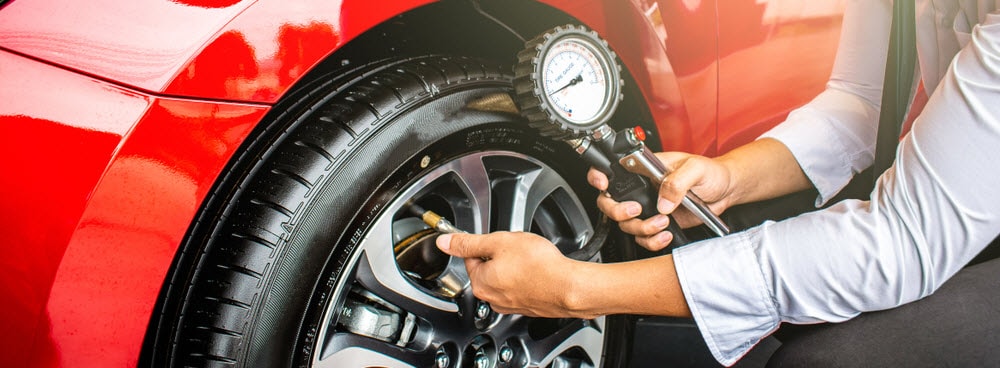
As a result, each car owner must clearly understand for himself that inflation (filling) of a tire with nitrogen has a number of advantages that not only help prolong the tire's performance, but also ensure comfort and safety on the road.
In summary, let's once again name the main advantages of pumping (filling) wheels with nitrogen:
class="w1000">
In our branch on the street. Sorge, d. 7A there is a cafe. In it, you can comfortably spend time watching the work on your car on the monitors, as well as using high-speed free WI-FI.
Moto rims: repair and tire fitting
Wheel bead polishing
Repair of side cuts and herniations
Wheel repair
Seasonal wheel storage
We accept for payment:
UNIFIED INFORMATION:
+7 (495) 799-02-20
24/7
ProfShinService
group of companies
Please introduce yourself
or
Select branch
Anokhina Zorge Rusakovskaya International Malygina Question to the DirectorYour question
x
Login or register
One of the latest trends in our automotive services market is the use of nitrogen in tires.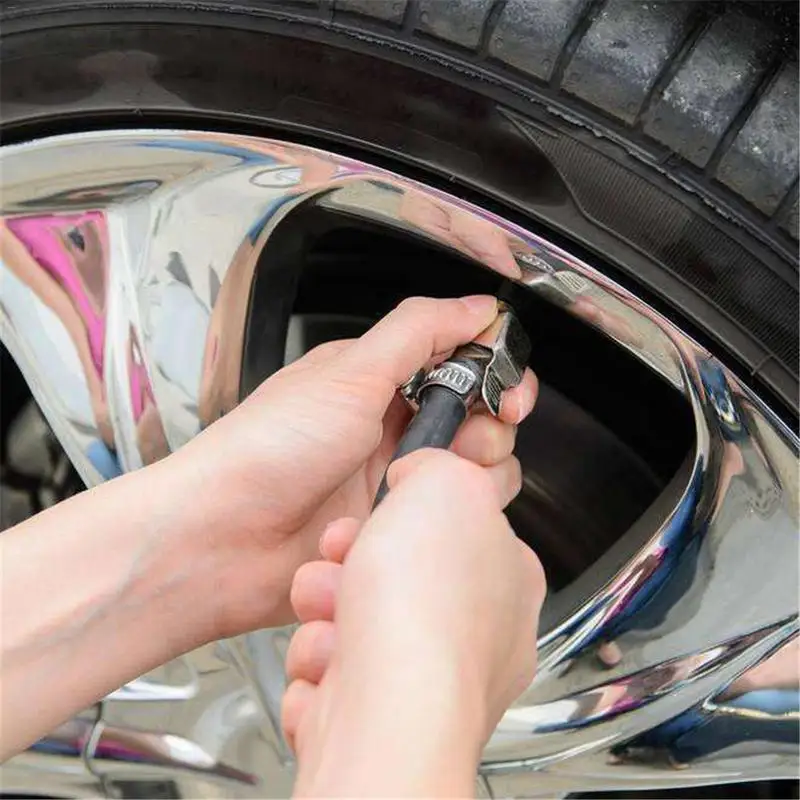 Fans of this method assure a significant reduction in fuel consumption. It is also believed that the wheels practically do not go down due to the larger size of the gas molecule compared to air. Many tire fitting stations and service centers offer refueling of tires with this gas.
Fans of this method assure a significant reduction in fuel consumption. It is also believed that the wheels practically do not go down due to the larger size of the gas molecule compared to air. Many tire fitting stations and service centers offer refueling of tires with this gas.
There are also opponents of the method who completely dismiss all the arguments of the supporters. Their main argument is the well-known fact that air is 78% nitrogen, 21% oxygen and other gases. Question: why inject another 15% nitrogen? It is unlikely that an additional volume of gas can dramatically improve the performance of a car tire. Moreover, this service costs more.
Let's look into the situation, consider all the pros and cons of nitrogen in tires.
In the automotive world, pumping nitrogen into tires has been around for a long time. True, this method was first used in the "royal" class of racing - Formula 1. However, like most other technologies that have been tested on cars before manufacturers start using them on production cars.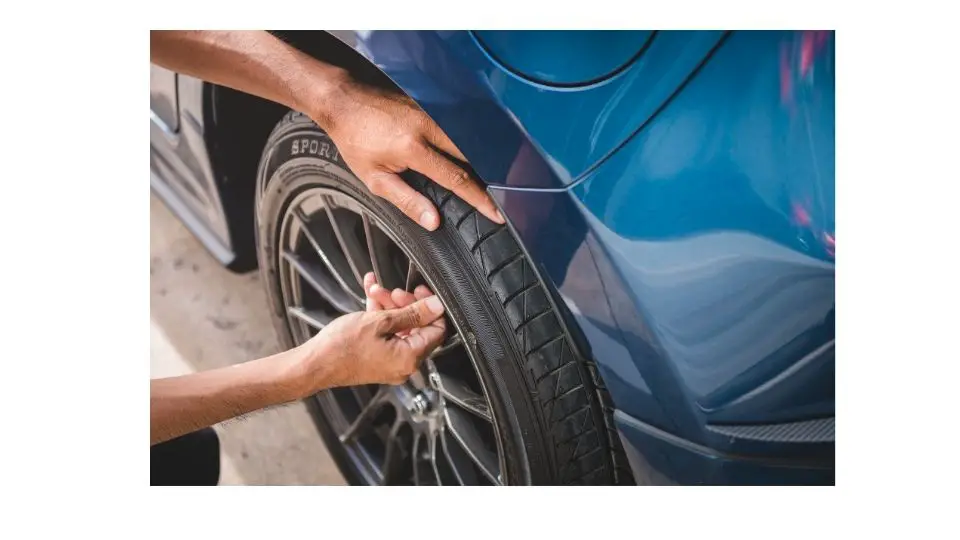 In this case, an air-nitrogen mixture was used, and not pure gas. The method was first used in the middle of the last century.
In this case, an air-nitrogen mixture was used, and not pure gas. The method was first used in the middle of the last century.
In the case of Formula 1, the use of this method provides at least one big plus - increased safety. The fact is that in the event of a car igniting, the air from the burst tire is an oxygen blower, igniting the flame even more. In the case of nitrogen injection into tires, this effect will no longer be, that is, the risk of fire is reduced.
In the US, nitrogen is used instead of air in tires in commercial vehicles. This is not a mandatory rule, but many truck owners and carriers use alternatives.
In ordinary life, cars are not often used to the limit of their capabilities, fires occur very rarely. Therefore, pumping gas instead of air just for the sake of greater safety is impractical, but there are other advantages.
Nitrogen tire inflation has both supporters and opponents. Moreover, they are present among professionals, including owners of tire stations and service stations, and among amateurs.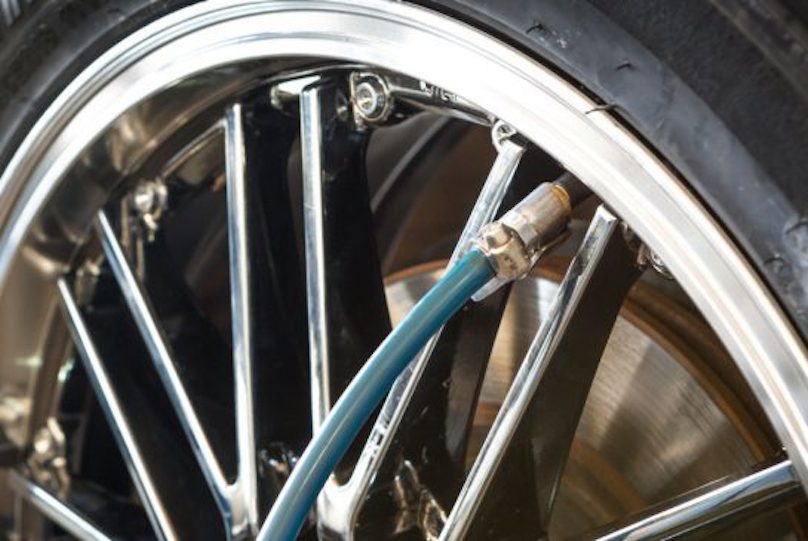 The advantages of the method include:
The advantages of the method include:
This is one of the most common arguments for nitrogen instead of air. Its essence boils down to the fact that the specified gas is lighter than air, respectively, the lower weight of the wheel will lead to a decrease in fuel consumption.
To do this, you need to deal with real numbers. A cubic meter of air, which is pumped into tires, has a weight of 1.29 kg, and a cubic meter of gas - 1.25 kg. A standard passenger car wheel holds about 75 grams of pure gas and 77 grams of air mixture. Therefore, the difference in fully inflated wheels will be a few grams, which is negligible for significant fuel savings.
The difference is almost imperceptible - much more weight on the wheel adds dirt between the treads or pebbles.
Summer Drive Protection Sound Comfort
Rating:
4.5
Tires Goodyear Eagle F1 Asymmetric 3 SUV
Summer Drive protection
Rating:
4.5
Tires Goodyear Eagle Sport TZ
Summer Drive protection
Rating:
4.5
Tires Goodyear EfficientGrip 2 SUV
Summer Drive Protection Run On Flat
Rating:
4. 5
5
Tires Goodyear EfficientGrip Performance
Winter Drive protection
Tires Goodyear UltraGrip Arctic 2 SUV
Winter Drive Protection Sound Comfort
Rating:
4.5
Tires Goodyear UltraGrip Ice 2
Winter Drive Protection Sound Comfort
Rating:
4.5
Tires Goodyear UltraGrip Ice SUV
Winter Drive protection
Tires Goodyear UltraGrip Performance+ SUV
All season Drive protection
Rating:
5
Tires Goodyear Vector 4Seasons Gen-3 SUV
Summer Drive Protection Run On Flat
Rating:
4
Tires Goodyear Wrangler HP All Weather
All season Drive protection
Rating:
4. 5
5
Tires Goodyear Vector 4Seasons
Summer
Rating:
4.5
Tires Goodyear Wrangler All-Terrain Adventure with Kevlar
Summer Drive protection
Rating:
4.5
Tires Goodyear EfficientGrip SUV
Summer Drive Protection Run On Flat
Rating:
4
Tires Goodyear Eagle F1 Asymmetric SUV
Stable pressure is another argument for fans to pump nitrogen into the wheel instead of regular air. In this case, the argument is the larger size of the gas molecule compared to the size of the oxygen molecule. Accordingly, oxygen seeps through microscopic cracks and holes in the tire faster. As a result, the pressure drops and the wheel lowers.
In this case, the argument is the larger size of the gas molecule compared to the size of the oxygen molecule. Accordingly, oxygen seeps through microscopic cracks and holes in the tire faster. As a result, the pressure drops and the wheel lowers.
Yes, it is. But do not forget that ordinary atmospheric air is 78% nitrogen, and only 21% oxygen. Therefore, when the pressure drops in the wheel, it is pumped up, thus adding even more nitrogen from ordinary air. For several years of operation, the wheel is almost completely inflated with gas alone.
Nitrogen practically does not expand when heated, so the pressure in the tire will remain the same as the temperature changes. In contrast to this statement, it is worth noting that more than three-quarters of the air is occupied by nitrogen. Other gases also do not expand much, so the pressure difference in tires filled with air or nitrogen when heated is not too great to take into account.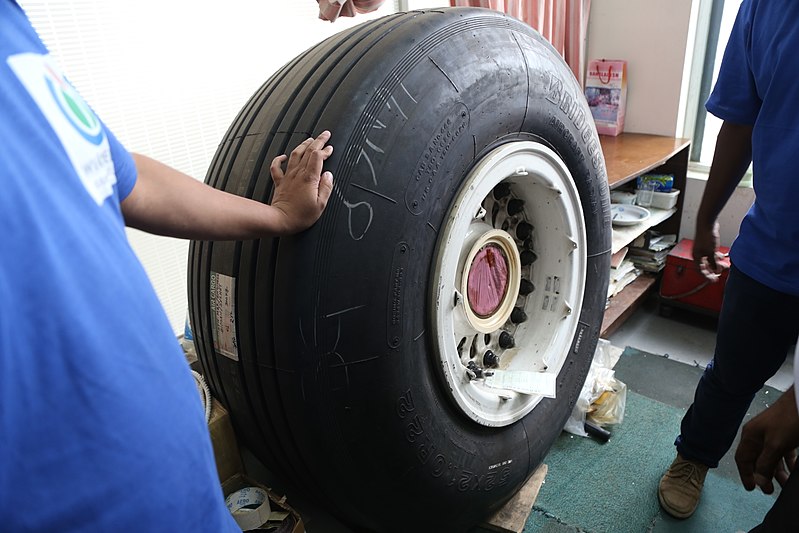
Proponents of the method claim that the absence of oxygen provides additional protection for the material from aging. Yes, this is a fair remark, but does it make any practical sense? Rubber is exposed to other factors - aggressive environment, moisture, sunlight, and so on. All this does not contribute to the extension of service life, but no one is going to use tires forever. There are certain operating times that are not significantly affected by the gas used.
A lower noise level indicates a tire filled with clean gas rather than atmospheric air. Yes, by simple measurements at a speed of 100 km / h, the noise level in the first case is 65 dB versus 68 dB in the second. Is it good or bad? Just imperceptibly - a difference of 3 dB is absolutely negligible.
A wheel filled with nitrogen is less likely to explode. In fact, the wheel will explode only in the case of ruthless operation of the car, which is very rare in ordinary life. Moreover, in fact, the wheel does not explode, but bursts - there is a sharp loss of pressure when the tire structure is destroyed. And this can happen when hitting an object or obstacle.
And this can happen when hitting an object or obstacle.
Also, do not pay serious attention to the advice of those who recommend less checking the tire pressure with nitrogen. Checking should be done as often as the manufacturer recommends, and the number of checks does not depend on the type of mixture. How much the wheel “holds” is largely influenced by the composition of the rubber, its condition. A normal tire without damage is able to hold pressure for years
But metal corrosion is more pronounced when air is used. The oxygen contained in it is an oxidizing agent. It enters into a chemical oxidation reaction even at low temperatures, affecting the wheel and rubber. This statement can be attributed to the really positive aspects of nitrogen injection.
The downside of using nitrogen instead of air in your car tire can be the price. After all, the technology provides for the removal of air from the wheel and then the injection of clean gas instead. Naturally, you need to think carefully about whether it is necessary to pump in nitrogen, or whether it is better to use the traditional method. We did not find significant advantages, representatives of the main tire brands have a similar opinion. To determine why to do this, you need to think carefully, because there are no pronounced advantages.
Naturally, you need to think carefully about whether it is necessary to pump in nitrogen, or whether it is better to use the traditional method. We did not find significant advantages, representatives of the main tire brands have a similar opinion. To determine why to do this, you need to think carefully, because there are no pronounced advantages.
Another disadvantage is the need to use special equipment, gas cylinders are also needed. This can only be afforded by special service centers for car maintenance, tire shops. Any car owner can inflate a tire with a compressor or even a simple pump, for this it is not necessary to be a professional. With nitrogen, this will not work - in a garage or in the middle of a highway you will not be able to pump gas, at least without the appropriate equipment.
The following shortcoming cannot be called a pure disadvantage of the method, but still its opponents often talk about it. The essence of their refutation boils down to the fact that in simple air the nitrogen content is at least 78%, so it makes no sense to pump in an additional 15%.
The argument for using nitrogen in tires is the smooth running of the vehicle. There is no obvious confirmation of this advantage, just the pressure in this case is slightly less - the wheel is under-inflated, which ensures smooth movement on uneven road surfaces.
It is a clear myth that when a tire is punctured, gas escapes more slowly than pure air. The reason for this is the larger size of its molecule. This is not true, and any puncture can “empty” the wheel in a matter of moments.
For example, in the rules of the notorious Formula 1, the elite of motorsport, there is no mandatory requirement to use nitrogen exclusively. Choice is provided, which means there is no advantage of one method over another. For road cars, the situation is similar, but with one clarification. The cost of using nitrogen in vehicle tires is much higher and this is a significant disadvantage. The question arises - why overpay if there are no benefits as such? The answer depends solely on the preferences of a particular car owner.